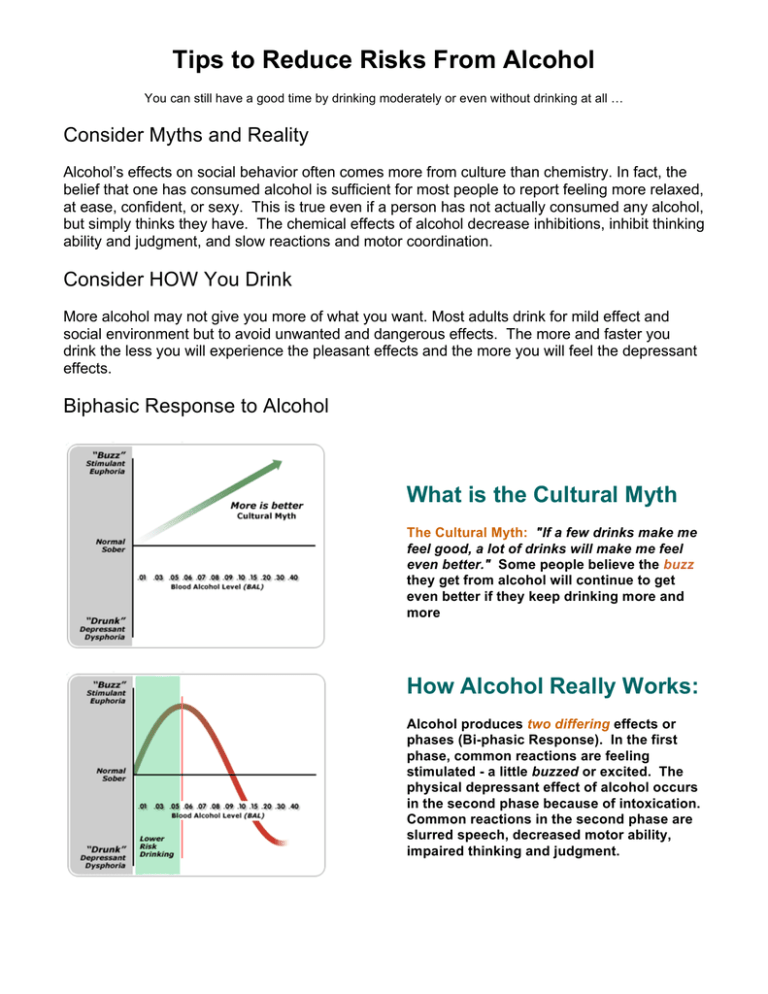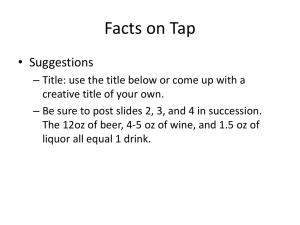Tips to Reduce Risks From Alcohol
advertisement

Tips to Reduce Risks From Alcohol You can still have a good time by drinking moderately or even without drinking at all … Consider Myths and Reality Alcohol’s effects on social behavior often comes more from culture than chemistry. In fact, the belief that one has consumed alcohol is sufficient for most people to report feeling more relaxed, at ease, confident, or sexy. This is true even if a person has not actually consumed any alcohol, but simply thinks they have. The chemical effects of alcohol decrease inhibitions, inhibit thinking ability and judgment, and slow reactions and motor coordination. Consider HOW You Drink More alcohol may not give you more of what you want. Most adults drink for mild effect and social environment but to avoid unwanted and dangerous effects. The more and faster you drink the less you will experience the pleasant effects and the more you will feel the depressant effects. Biphasic Response to Alcohol What is the Cultural Myth The Cultural Myth: "If a few drinks make me feel good, a lot of drinks will make me feel even better." Some people believe the buzz they get from alcohol will continue to get even better if they keep drinking more and more How Alcohol Really Works: Alcohol produces two differing effects or phases (Bi-phasic Response). In the first phase, common reactions are feeling stimulated - a little buzzed or excited. The physical depressant effect of alcohol occurs in the second phase because of intoxication. Common reactions in the second phase are slurred speech, decreased motor ability, impaired thinking and judgment. Tolerance: "It's not a good thing.." The curved yellow line illustrates that as you develop tolerance, the buzz or positive feelings are less. The depressant or negative phase lasts longer and your risk for negative experience increases. It's About Balance: The Point of Diminishing Returns (.055 BAL or less) usually gives people the experience they want from drinking. It is also the point when drinking more will not make you feel better or have a better time. You will just get more intoxicated and the negative risks of drinking will increase Tips for Reducing Risks from Alcohol • • • • • • • • • • • Plan ahead. Set a reasonable limit and stick to it. Try keeping blood alcohol level (BAL) of .05% or less. Think quality, not quantity and keep track. Experiment with drinking less and/or refusing drinks. Switch to drinks that contain less or no alcohol. Eat before you drink. Slow down. It takes about 20 minutes for you to feel the effects of a single drink. Measure. Know how much alcohol is in your drink. Drink water before, during, and after drinking alcohol. Check your mood. Alcohol intensifies mood. Avoid drinking if you feel angry or depressed. Drink less at large parties, not more. Consider going early and leaving early. Avoid drinking games. Tips for Reducing Risk Associated with Alcohol & Sex • • • • • Unwanted or unprotected sex often occurs under the influence of alcohol. On dates or at parties, be selective about when and how you drink Alcohol does NOT improve sexual performance or enjoyment. Nor does it make you more attractive, funnier, or a better dancer. Look out for your friends. The best intention to use condoms or other latex protection is inhibited by alcohol. Tips for Drinking and (NOT) Driving • • • • • Volunteer to be a designated driver if you think tonight is likely to be a “heavy drinking” night. Arrange for your transportation needs before going to the party or drinking occasion. Select a reliable designated driver who agrees to stay sober. Leave our car keys home or give them to a designated driver. We recommend not driving if you have had any alcohol at all. If you are under 21, you can be cited for DUI or minor in possession if you have any alcohol in your system. If you are over 21 the legal BAL is up to .08%. Adapted from Prevention and Wellness Services Western Washington University


